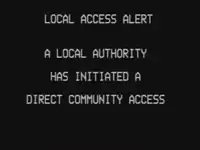 | |
| Type | Emergency warning system |
|---|---|
| Country | United States, some other countries |
| TV stations | Some broadcast television stations and cable systems |
Broadcast area | Mostly areas that have not upgraded to the Emergency Alert System. |
Launch date | Date Unknown |
| Replaced by | Emergency Alert System |
The Local Access Alert (also known as Local Access System or Emergency Override System) is a warning system designed to warn radio, television stations, cable television broadcast feeds or satellite signals of impending dangers, such as tornadoes, flash flooding and other civil emergencies. The system was largely replaced by the Emergency Alert System "[1]". in the United States, although it still exists in some areas which have not yet been upgraded, and is still used from time to time in areas that have upgraded to the EAS.


The Local Access Alert was used by local law enforcement agencies and emergency management staff and is much like the antiquated Emergency Broadcast System. A public servant would dial up a number and PIN through a phone to take control of a certain cable city or cluster in the path of danger. Once the number and PIN are entered, it switches all cable subscribers, regardless of what channel they're on, to either a black screen, a white screen, a colored screen depending on warning, a slide, or static and uses a distinct attention signal (in this case, a morse code, a siren, DTMF tones, steady single (or dual) tones, or multiple hi-lo beeps). On some occasions, some Local Access Alerts only interrupt audio, instead of both the video and audio. More modern alerts use a black screen with the words "Local Access Alert" in all capital letters with a message stating that "a local authority has initiated a direct community access"; the text was generated using the Trilithic EASyPLUS character generator (the same one that was also used for the Emergency Alert System).
Police or emergency management then let viewers know of an impending disaster and instruct them to take shelter or evacuate. The problem with the Local Access Alert system is that the operators would have to dial out to end transmission. Simply hanging up the phone connected to the system after an emergency broadcast would not work, and sometimes viewers would hear other phone noises (examples: off-hook and/or a dial tone) before finally being switched back to normal cable operations.
With a gradual transition from analog to digital cable, the Local Access Alert has been phased out and replaced by the Emergency Alert System, which employs Specific Area Message Encoding technology to activate for potential disasters and deactivate to resume cable broadcasts, especially late at night when many public servants aren't available to break in.
History
The first known Emergency Override Systems or Local Access Alerts were delivered during the boom of cable television in the 1960s, although it was not directly (and mainly) called the two main names of systems, as they sometimes pronounced it in various names. As of the late-1960s and early-1970s, Local Access Alerts began to spread all over the country; although not a lot of cities and towns had cable television yet. When cable systems continued to grow, the Local Access Alert was added on most occasions.
Local Access Alerts gained the most popularity on local cable systems from the latter half of the 1970s until the end of the 1990s, when the Emergency Alert System began to take the role on cable television after the EAS replaced the Emergency Broadcast System on January 1, 1997. The Emergency Alert System began to build up on most cable television systems through the installation of then-new generators and encoders between 1997 and 1999. Some of the notable EAS generators at the time include Video Data Systems, Texscan, Gorman-Redlich, Idea/Onics, Cable Envoy, and Trilithic; and encoders include SAGE and TFT models. During the cable growth of the Emergency Alert System, only some cable systems retained the Local Access Alert equipment up into the first part of the 2010s.
As of the late-2000s and early-2010s, most of the remaining cable systems that still used Local Access Alerts used either both Trilithic EASyPLUS or Video Data Systems as their modern screens instead of the previously used older systems such as CommAlert (although older systems of the Local Access Alert were still used in a handful of areas at the time), but by the end of the 2010s, the popularity of Local Access Alerts became nearly extinct on most cable systems in the United States as all cable systems already had the Emergency Alert System, which at that time, local cable systems had become either Comcast, Time Warner Cable, or Suddenlink among others.
Nowadays, most Local Access Alerts are practically delivered as Practice/Demo Warnings as part of the Emergency Alert System, but the remainder of the nearly-extinct Local Access Alerts can still be seen on a minimum amount of very small cable systems that haven't either upgraded its equipment or become part of a major company in unincorporated or very minor areas.
Activations
Local Access Alerts were activated for all kinds of emergencies. More commonly, it was mainly activated whenever weather warnings, watches, and advisories such as tornadoes, flash flooding, or severe thunderstorms were issued in a local area or the surrounding areas that served the viewing area of the cable system, as well as civil emergencies and major weather events (Earthquakes, Blizzards, Winter Storms, Hurricanes, and Tsunamis), Amber Alerts, traffic closures, 911 outages, forest fires, dam failures, and road conditions. Test activations of the Local Access Alert occur once weekly at randomly selected times, as well as scheduled monthly tests and yearly tornado drills. All kinds of emergencies were directly similar to activations for both the Emergency Broadcast System and the Emergency Alert System.
References
1 https://en.wikipedia.org/wiki/2011_T%C5%8Dhoku_earthquake_and_tsunami
2 https://education.nationalgeographic.org/resource/tohoku-earthquake-and-tsunami/